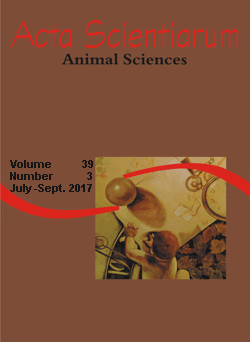<b>Nutritional value of dual-purpose wheat genotypes pastures under grazing by dairy cows
Abstract
In the south of Brazil, one of the major limitations to milk production is the low forage availability during autumn and early winter. The use of dual-purpose wheat genotypes is one alternative to minimize the impact of low forage availability in addition to produce grains. Therefore, this study aimed to evaluate the nutritional value of two dual-purpose wheat genotypes (BRS Tarumã and BRS Umbu). Structural composition and forage nitrogen uptake were evaluated. The nutritional value of the forage was analyzed for mineral matter (MM), organic matter (OM), neutral detergent fiber (NDF), crude protein (CP), total digestible nutrients (TDN), in situ organic matter digestibility (ISOMD) and in situ dry matter digestibility (ISDMD). Differences in NDF (49.03 vs. 46.44%), CP (24.4 vs. 27.4%), ISOMD (83.53 vs. 85.45%), ISDMD (83.59 vs. 86.65%) and TDN (75.37 vs. 78.39) for BRS Umbu and BRS Tarumã genotypes were detected, respectively. The BRS Umbu genotype had a lower leaf blade proportion and forage nitrogen uptake. The dual-purpose wheat genotype BRS Tarumã was superior in nutritive value.
Downloads
DECLARATION OF ORIGINALITY AND COPYRIGHTS
- I Declare that current article is original and has not been submitted for publication, in part or in whole, to any other national or international journal.
The copyrights belong exclusively to the authors. Published content is licensed under Creative Commons Attribution 4.0 (CC BY 4.0) guidelines, which allows sharing (copy and distribution of the material in any medium or format) and adaptation (remix, transform, and build upon the material) for any purpose, even commercially, under the terms of attribution.
Read this link for further information on how to use CC BY 4.0 properly.








































